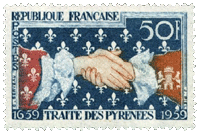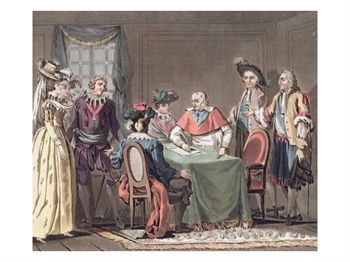
![]() For
many centuries the Kings of Aragon had owned territory north
of the Pyrenees
(
For
many centuries the Kings of Aragon had owned territory north
of the Pyrenees
( Pirenèus,
Pirenèus,
 Pirineus,
Pirineus,
 Pyrénées).
It was repeadely attacked and for periods held by armies
from the French side of the Pyrenees.
Louis XI had aquired Roussillon
and Cerdagne land in 1462-63, but it had been abandoned
again in 1493, by Charles VIII, under the Treaty of Barcelona.
In 1642 the Roussillon
was seized once again, and Perpignan
was taken, leading to further disputes.
Pyrénées).
It was repeadely attacked and for periods held by armies
from the French side of the Pyrenees.
Louis XI had aquired Roussillon
and Cerdagne land in 1462-63, but it had been abandoned
again in 1493, by Charles VIII, under the Treaty of Barcelona.
In 1642 the Roussillon
was seized once again, and Perpignan
was taken, leading to further disputes.
After centuries of to-ing and fro-ing the present border was settled in 1659 by a treaty called the Treaty of the Pyrenees, (signed at Pheasant Islandon on the Bidasoa River) which brought the Roussillon and thirty-three villages of the Cerdagne under the French crown.
If you look at a map of the Pyrénées-Orientales
département you will notice that there is
a small enclave labelled Llivia with a national boundary
marker around it - a little to the east of Andorra.
This is not an error, at least not by the map maker. The story is that the treaty included all the villages to be transferred to Spain, but someone neglected to include the one town in the area - Llivia. So it was that this town is still in Spain. This is not just a technicality - the language, schools, post, police, even the food, is still Spanish. Before the Euro was introduced the currency here was the Spanish paseta. Whenever diplomatic relations between France and Spain become strained the borders are defended like any other national border. |
|
As a result of the treaty the old border defenses, Carcassonne and the "five sons of Carcassone" (the castles of Aguila, Peyrepertuse, Queribus, Puilaurens and Termes) were slighted or left to decay.
The Treaty prompted the king, Louis XIV, to commission a miltary engineer to build new border defences. The work was untertaken by de Vauban, an engineer of genius, whose work is as impressive today as when it was built. To see some examples of his work in the Languedoc-Roussillon, click here.







